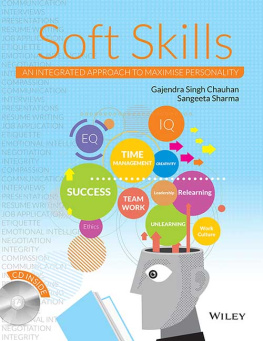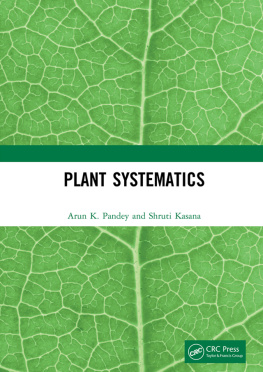Gurcharan Singh - Plant systematics : an integrated approach
Here you can read online Gurcharan Singh - Plant systematics : an integrated approach full text of the book (entire story) in english for free. Download pdf and epub, get meaning, cover and reviews about this ebook. year: 2019, genre: Romance novel. Description of the work, (preface) as well as reviews are available. Best literature library LitArk.com created for fans of good reading and offers a wide selection of genres:
Romance novel
Science fiction
Adventure
Detective
Science
History
Home and family
Prose
Art
Politics
Computer
Non-fiction
Religion
Business
Children
Humor
Choose a favorite category and find really read worthwhile books. Enjoy immersion in the world of imagination, feel the emotions of the characters or learn something new for yourself, make an fascinating discovery.
- Book:Plant systematics : an integrated approach
- Author:
- Genre:
- Year:2019
- Rating:5 / 5
- Favourites:Add to favourites
- Your mark:
- 100
- 1
- 2
- 3
- 4
- 5
Plant systematics : an integrated approach: summary, description and annotation
We offer to read an annotation, description, summary or preface (depends on what the author of the book "Plant systematics : an integrated approach" wrote himself). If you haven't found the necessary information about the book — write in the comments, we will try to find it.
Plant systematics : an integrated approach — read online for free the complete book (whole text) full work
Below is the text of the book, divided by pages. System saving the place of the last page read, allows you to conveniently read the book "Plant systematics : an integrated approach" online for free, without having to search again every time where you left off. Put a bookmark, and you can go to the page where you finished reading at any time.
Font size:
Interval:
Bookmark:

Fourth Edition
Gurcharan Singh
Retired Associate Professor
University of Delhi, New Delhi, India

CRC Press
Taylor & Francis Group
6000 Broken Sound Parkway NW, Suite 300
Boca Raton, FL 33487-2742
2019 by Taylor & Francis Group, LLC
CRC Press is an imprint of Taylor & Francis Group, an Informa business
No claim to original U.S. Government works
Printed on acid-free paper
Version Date: 20190302
International Standard Book Number-13: 978-0-429-28952-1 (eBook - PDF)
This book contains information obtained from authentic and highly regarded sources. Reasonable efforts have been made to publish reliable data and information, but the author and publisher cannot assume responsibility for the validity of all materials or the consequences of their use. The authors and publishers have attempted to trace the copyright holders of all material reproduced in this publication and apologize to copyright holders if permission to publish in this form has not been obtained. If any copyright material has not been acknowledged please write and let us know so we may rectify in any future reprint.
Except as permitted under U.S. Copyright Law, no part of this book may be reprinted, reproduced, transmitted, or utilized in any form by any electronic, mechanical, or other means, now known or hereafter invented, including photocopying, microfilming, and recording, or in any information storage or retrieval system, without written permission from the publishers.
For permission to photocopy or use material electronically from this work, please access www.copyright.com (http://www.copyright.com/) or contact the Copyright Clearance Center, Inc. (CCC), 222 Rosewood Drive, Danvers, MA 01923, 978-750-8400. CCC is a not-for-profit organization that provides licenses and registration for a variety of users. For organizations that have been granted a photocopy license by the CCC, a separate system of payment has been arranged.
Trademark Notice: Product or corporate names may be trademarks or registered trademarks, and are used only for identification and explanation without intent to infringe.
Library of Congress Cataloging-in-Publication Data
Names: Singh, Gurcharan, 1945- author.
Title: Plant systematics : an integrated approach / Gurcharan Singh.
Description: First edition. | Boca Raton, FL : CRC Press/Taylor & Francis
Group, [2019] | Includes bibliographical references and index.
Identifiers: LCCN 2019007826 | ISBN 9780367250881 (hardback)
Subjects: LCSH: Plants--Classification.
Classification: LCC QK95 .S572 2019 | DDC 580.1/2--dc23
LC record available at https://lccn.loc.gov/2019007826
Visit the Taylor & Francis Web site at
http://www.taylorandfrancis.com
and the CRC Press Web site at
http://www.crcpress.com
The fourth edition of Plant Systematics: An Integrated Approach has been revised and reorganised thoroughly, and significantly updated to incorporate the developments of the last few years. The publication of current edition was forced mainly because of publication of revision of International Code of Nomenclature for Algae, Fungi and Plants (Shenzhen Code, 2018), new version of PhyloCode (Beta version of Phylocode 5, 2014), updated APweb version 14 (September, 2018 update), revised Angiosperm Phylogeny Group classification APG IV (2016), new Pteridophyte Phylogeny Group Classification PPG I (2016) and accumulation of large amount of information subsequent to the publication of third edition. There has been development of new tools of biotechnology, vigorous utilization of molecular data in understanding phylogeny, and redefining of affinities and arrangements of plant groups. Recent years have also seen disappearance of gaps between numerical and cladistical methodologies, and integration of former into latter for complete understanding of phylogenetic relationships. These trends have largely influenced the combination of numerical and cladistic methods under one chapter, and enlarged discussion on Molecular Systematics, discussing new concepts, tools and recent achievements and need to align these with morphological traits so that plants can be conveniently identified in the field. New chapters on Pteridophytes and Gymnosperms added in third edition have been retained and updated for complete understanding of systematics of vascular plants.
Actual photographs of plants and plant parts enable better understanding of taxonomic information. This practice (of using actual photographs) has been followed in several other recent publications too. The present edition incorporates numerous photographs of plants from diverse families of plants (color in the ebook, B&W in the print version). This has largely been possible with the assistance of my son Manpreet Singh who sponsored my recent visit to California and provided me the opportunity to visit and photograph temperate plants in and around California. The book, as such, contains images of both tropical plants, Himalayan plants, temperate American plants and plants from other parts of the world growing in the Botanical Gardens of University of California and San Francisco Botanical Garden, as also natural forest regions in California. In addition, 305 black & white illustrations help in a better understanding of the plants covered in the book.
The recent decades have seen major changes in schemes of classification of angiosperms. The traditional distinction between dicots and monocots seems to be disappearing, dicots are being split into the basal families and more advanced eudicots, and monocot families interpolated between these two groups of dicots. Whereas Angiosperm Phylogeny Group is attempting to establish monophyletic groups at the most up to the order level, grouped into informal groups, Thorne aims at blending these developments with the traditional Linnaean hierarchy. Both sets of classification have undergone major modifications in the recent years, such as the latest version of Thornes classification (2007), Takhtajans classification (revised in 2009), APG III (2009), APG IV (2016) and APweb Version 14 (2017). Attempts are also being made to provide unified Code of nomenclature for all living organisms.
The author has attempted to strike a balance between classical fundamental information and the recent developments in plant systematics. Special attention has been devoted to the information on botanical nomenclature, identification and phylogeny of angiosperms with numerous relevant examples and detailed explanation of important nomenclatural problems. An attempt has been made to present a continuity between orthodox and contemporary identification methods by working on a common example. The methods of identification using computers have been further explored to help better on-line identification. Outputs of computer programs especially used in molecular studies and construction of phylogenetic trees have been included based on actual or hypothetical data. This will acquaint readers with the handling of raw data and working of computer programs.
Internet highways are revolutionizing the exchange of scientific information. Botanical organizations have plunged into this revolution in a big way. Instant information on major classification systems, databases, herbaria, gardens, indices and thousands of illustrations are available to users Worldwide at the touch of a button. Discussion on important aspects of this information highway and useful links have been provided in this book. My interaction with colleagues especially the members of the list Taxacom, efloraofindia Facebook groups Plant Identification, California Native Plant Society and Indian Flora has been very helpful in resolving some doubts. I am greatful to all members whose information has been valuable on several occasions.
Font size:
Interval:
Bookmark:
Similar books «Plant systematics : an integrated approach»
Look at similar books to Plant systematics : an integrated approach. We have selected literature similar in name and meaning in the hope of providing readers with more options to find new, interesting, not yet read works.
Discussion, reviews of the book Plant systematics : an integrated approach and just readers' own opinions. Leave your comments, write what you think about the work, its meaning or the main characters. Specify what exactly you liked and what you didn't like, and why you think so.













